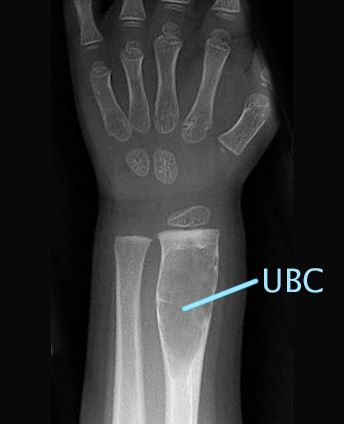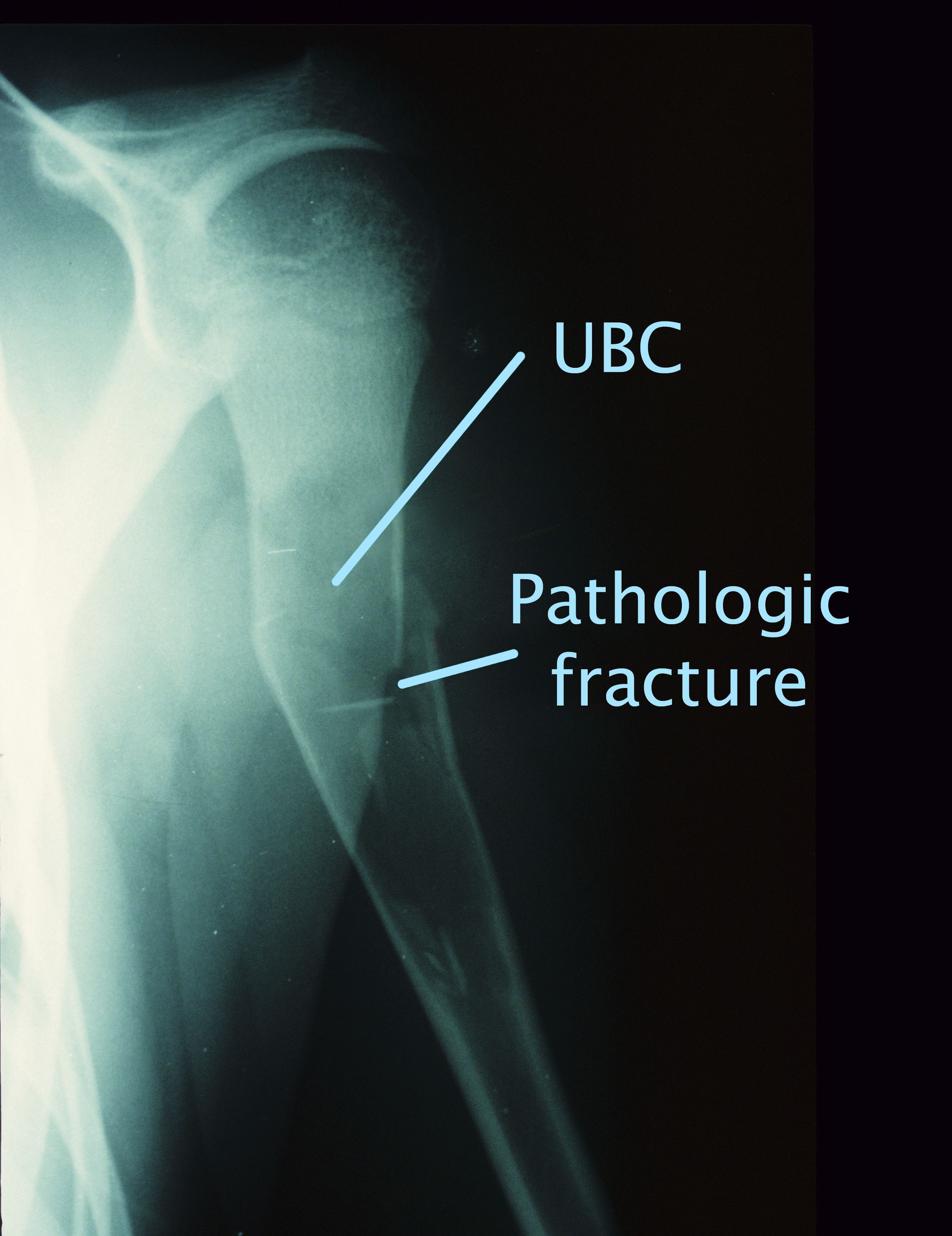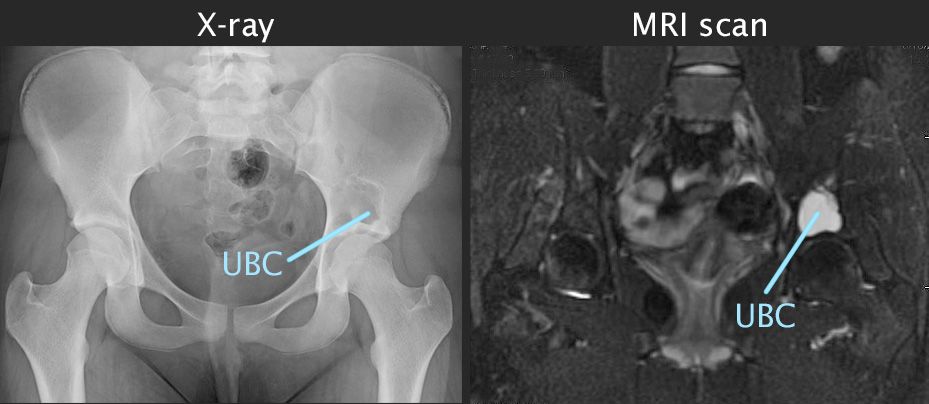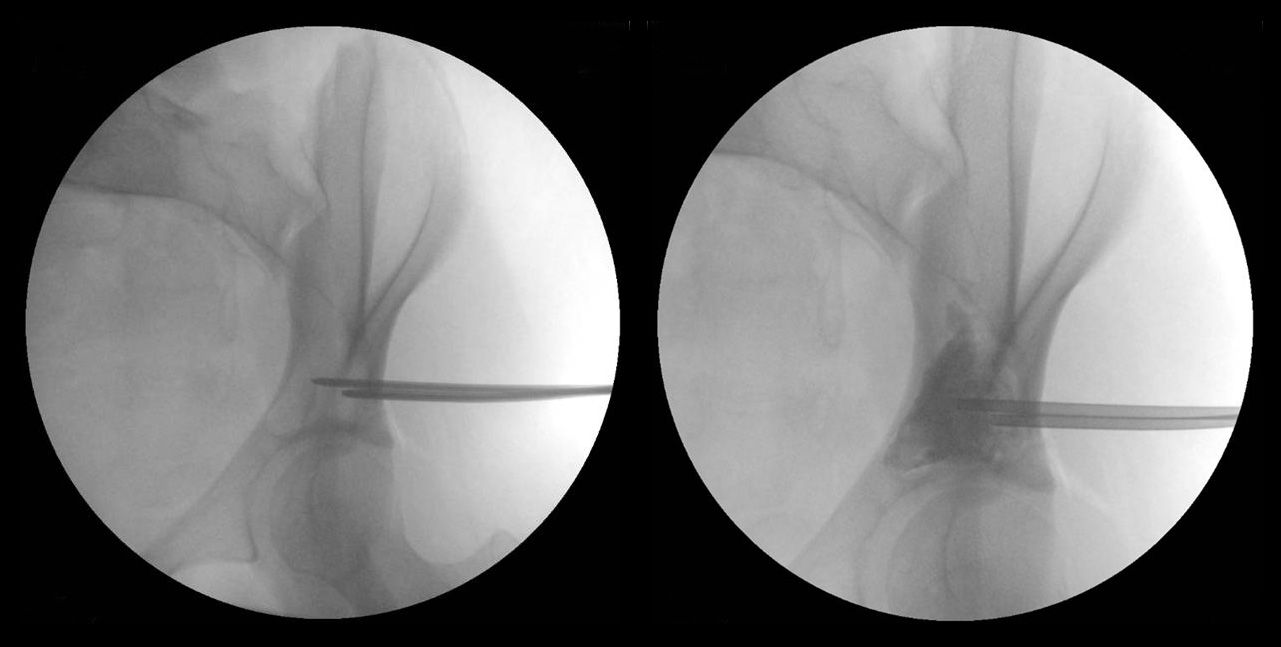Diseases & Conditions
Unicameral Bone Cysts
A unicameral bone cyst (UBC), or simple bone cyst, is a common, benign (noncancerous) bone tumor that primarily occurs in children and adolescents.
UBCs are cavities within bone that are filled with fluid. Although they can develop in any bone, UBCs usually affect the long bones — most often the humerus (upper arm bone) and the femur (thighbone).
In most cases, unicameral bone cysts are not painful, and are often discovered incidentally (by accident) when an X-ray is taken for another reason. Because these cysts can weaken the surrounding bone, fractures through UBCs do occur.
Treatment for a UBC is based on several factors, including the size and location of the cyst, and the risk of fracture. In some cases, surgery may be recommended.
Description
Unicameral bone cysts (UBCs) are one of the more common noncancerous bone tumors that affect children. The true number of these tumors is not known because many are never discovered.
Unicameral bone cysts:
- Are found more frequently in boys than in girls.
- Do not metastasize (spread to other parts of the body).
- Most often occur in just one bone, typically at the end of the bone, near a joint and growth plate. Growth plates are areas of developing cartilage tissue near the ends of long bones in children. The growth plate helps determine the length and shape of the adult bone.
As a bone grows, the shape and size of a cyst can change. Usually, the cyst will stop growing when the child is full-grown, and then will gradually fill in with normal bone and disappear.
Doctors classify unicameral bone cysts according to whether the cyst develops next to a growth plate.
- Active. These cysts are in contact with the growth plate. They can grow large enough to weaken bone and cause fracture. An active cyst can expand into and damage the growth plate, resulting in bone deformity or limbs of uneven length.
- Latent. These cysts are not in contact with the growth plate. As the bone grows, the distance between the growth plate and latent cyst becomes greater.
Cause
It is not known what causes unicameral bone cysts to form. Likely, as the bone is growing, the body accidentally lays down the wrong tissue or a cyst lining that fills with fluid.
Symptoms
Most unicameral bone cysts do not cause symptoms and are discovered incidentally (by accident). This happens when an X-ray or other test is performed for an unrelated problem and the cyst is seen on the X-ray.
Some cysts are discovered after the bone breaks. Bones are made of:
- A strong, dense outer tube called the cortex.
- A squishy, spongy inner bone called trabecular bone. Trabecular bone is found inside of the intramedullary canal (also known as the intramedullary cavity or intramedullary space) of the bone.
A cyst grows in the intramedullary space. As it grows, it can make the cortex thinner and weaken the bone over time, putting the bone at risk for fracture (break). Because it causes no symptoms, a bone weakened by a cyst can break with just a minor injury, such as a fall from standing height. This type of fracture (broken bone) is called a pathologic fracture.
Less commonly, a patient may notice a painless bump if the cyst has caused the bone to enlarge in a specific area.
Doctor Examination
To confirm a diagnosis of unicameral bone cyst, the doctor will order imaging tests — most important, X-rays.
X-rays
X-rays provide clear pictures of dense structures like bone and will usually show a UBC quite well. In most cases, a plain X-ray is the only imaging test a doctor needs to diagnose a unicameral bone cyst.
Differential Diagnosis
Sometimes, additional imaging tests are necessary to distinguish a unicameral bone cyst from another common noncancerous bone cyst: an aneurysmal bone cyst (ABC).
Although it can resemble a UBC in an X-ray, an aneurysmal bone cyst is formed by a group of blood-filled cysts. This type of cyst can occasionally grow very large and cause serious deformity to the bone. Aneurysmal and unicameral bone cysts require different treatment methods so it is important for the doctor to know which type of cyst the patient has.
In certain cases, a magnetic resonance imaging (MRI) scan or computerized tomography (CT) scan may be ordered to provide more detailed images of the cyst.
- An MRI scan of an aneurysmal bone cyst will show multiple cavities filled with fluid.
- An MRI of a UBC will show a single fluid-filled cavity.
If these tests do not adequately reveal the answer, a biopsy may be necessary. In a biopsy, a sample of the fluid within the cyst is taken and examined under a microscope.
Treatment
To determine the appropriate treatment, the doctor will consider a range of factors, including:
- The size of the cyst
- The strength of the bone
- Your child's activity level
- Any symptoms your child may be experiencing
If a cyst is small and not causing symptoms, it often can be simply observed. If a cyst is large enough to cause concern about the bone breaking with mild force, surgery is an option to reduce the risk of fracture.
If the bone has already broken through the cyst, the fracture will typically heal without surgery. Some cysts (approximately 25%) will completely heal along with the fracture. If the cyst is still present after the fracture has healed, surgery may be recommended to prevent another fracture.
Nonsurgical Treatment
Observation. In some cases of unicameral bone cyst, treatment consists of careful observation over time. The doctor may want to take regular X-rays to keep track of any changes in the cyst.
Activity Modification. If your child is not very active in sports or other high-risk activities, the risk of fracture will be lower. The doctor may combine observation with maintaining a specific level of activity until your child is fully-grown and the cyst goes away.
Surgical Treatment
The doctor may recommend surgery if the cyst is:
- Painful
- Growing larger
- In a location that may cause fracture
Several different types of operations have been shown to have good results.
Aspiration and injection. In this procedure, needles are inserted into the cyst to drain the fluid. This is called an aspiration. The cyst is then injected with substances to decrease the chance of the cyst coming back. Sometimes, a series of injections is performed over several months.
Curettage and bone graft. In this procedure, the cyst is aspirated and then scraped out of the bone. After curettage, the doctor may fill the hole with a bone graft; this is bone taken from a donor (allograft) or from another bone in your child's body (autograft). The doctor may also use a bone cement mixture to fill the hole.
General anesthesia (your child is put to sleep) is most often used for both surgical options. Both options are also typically done as outpatient procedures, meaning patients are able to go home after a period of observation in the recovery area.
Recovery
How long it takes to return to daily activities after surgery will vary depending on the size and location of the cyst. Most patients can return to full activity within 3 to 6 months. The doctor will provide specific instructions to guide recovery.
Outcomes
Regardless of the treatment method chosen, unicameral bone cysts come back in the same location 25 to 50% of the time. Generally, the younger the child is when the cyst is treated, the higher the chance of the cyst returning. Your child's doctor will schedule regular X-rays and follow-up appointments to check for recurrence.
Once a child is full-grown, these cysts typically stop growing and fill in with bone.
Research on the Horizon
- The cause of unicameral bone cysts remains unknown, but continues to be investigated with ongoing research.
- Other research is aimed at developing better agents to inject into the cysts to keep them from coming back.
Researchers are also trying to discover ways to prevent UBCs from forming.
Last Reviewed
October 2025
Contributed and/or Updated by
Peer-Reviewed by
AAOS does not endorse any treatments, procedures, products, or physicians referenced herein. This information is provided as an educational service and is not intended to serve as medical advice. Anyone seeking specific orthopaedic advice or assistance should consult his or her orthopaedic surgeon, or locate one in your area through the AAOS Find an Orthopaedist program on this website.










